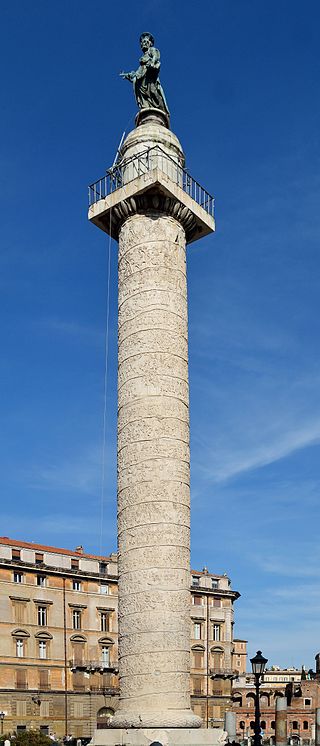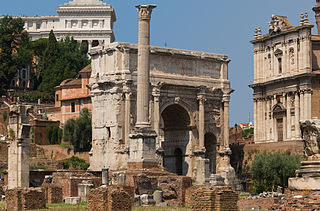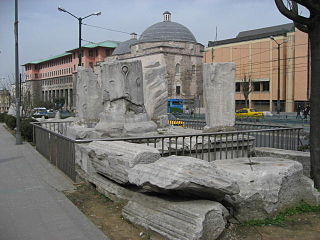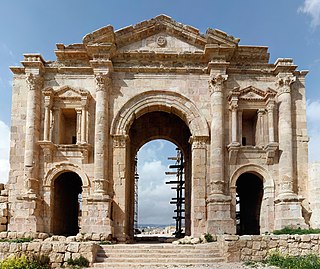
The 110s was a decade that ran from January 1, AD 110, to December 31, AD 119.

Ancona is a city and a seaport in the Marche region in central Italy, with a population of around 101,997 as of 2015. Ancona is the capital of the province of Ancona and of the region. The city is located 280 km (170 mi) northeast of Rome, on the Adriatic Sea, between the slopes of the two extremities of the promontory of Monte Conero, Monte Astagno and Monte Guasco.

Ancient Roman architecture adopted the external language of classical Greek architecture for the purposes of the ancient Romans, but was different from Greek buildings, becoming a new architectural style. The two styles are often considered one body of classical architecture. Roman architecture flourished in the Roman Republic and to even a greater extent under the Empire, when the great majority of surviving buildings were constructed. It used new materials, particularly Roman concrete, and newer technologies such as the arch and the dome to make buildings that were typically strong and well-engineered. Large numbers remain in some form across the former empire, sometimes complete and still in use today.

Trajan's Column is a Roman triumphal column in Rome, Italy, that commemorates Roman emperor Trajan's victory in the Dacian Wars. It was probably constructed under the supervision of the architect Apollodorus of Damascus at the order of the Roman Senate. It is located in Trajan's Forum, north of the Roman Forum. Completed in AD 113, the freestanding column is most famous for its spiral bas relief, which depicts the wars between the Romans and Dacians. Its design has inspired numerous victory columns, both ancient and modern.

A triumphal arch is a free-standing monumental structure in the shape of an archway with one or more arched passageways, often designed to span a road. In its simplest form a triumphal arch consists of two massive piers connected by an arch, crowned with a flat entablature or attic on which a statue might be mounted or which bears commemorative inscriptions. The main structure is often decorated with carvings, sculpted reliefs, and dedications. More elaborate triumphal arches may have multiple archways.

The Arch of Constantine is a triumphal arch in Rome dedicated to the emperor Constantine the Great. The arch was commissioned by the Roman Senate to commemorate Constantine's victory over Maxentius at the Battle of Milvian Bridge in AD 312. Situated between the Colosseum and the Palatine Hill, the arch spans the Via Triumphalis, the route taken by victorious military leaders when they entered the city in a triumphal procession. Dedicated in 315, it is the largest Roman triumphal arch, with overall dimensions of 21 m (69 ft) high, 25.9 m (85 ft) wide and 7.4 m (24 ft) deep. It has three bays, the central one being 11.5 m (38 ft) high and 6.5 m (21 ft) wide and the laterals 7.4 m (24 ft) by 3.4 m (11 ft) each. The arch is constructed of brick-faced concrete covered in marble.

A victory column, or monumental column or triumphal column, is a monument in the form of a column, erected in memory of a victorious battle, war, or revolution. The column typically stands on a base and is crowned with a victory symbol, such as a statue. The statue may represent the goddess Victoria; in Germany, the female embodiment of the nation, Germania; in the United States either the female embodiment of the nation Liberty or Columbia; in the United Kingdom, the female embodiment Britannia, an eagle, or a war hero.

The Arch of Septimius Severus at the northwestern end of the Roman Forum is a white marble triumphal arch dedicated in 203 A.D. to commemorate the Parthian victories of Emperor Septimius Severus and his two sons, Caracalla and Geta, in the two campaigns against the Parthians of 194-195 A.D. and 197–199 A.D. After the death of Septimius Severus, his sons Caracalla and Geta were initially joint emperors. Caracalla had Geta assassinated in 212 A.D.; in the practice now known as damnatio memoriae, Geta's memorials were destroyed and all images or mentions of him were removed from public buildings and monuments. Accordingly, Geta's image and inscriptions referring to him were removed from the arch.

Trajan's Bridge, also called Bridge of Apollodorus over the Danube, was a Roman segmental arch bridge, the first bridge to be built over the lower Danube and one of the greatest achievements in Roman architecture. Though it was only functional for 165 years, it is often considered to have been the longest arch bridge in both total and span length for more than 1,000 years.

Apollodorus of Damascus was a Damascus-born Greek architect and engineer from Roman Syria, who flourished during the 2nd century AD. As an engineer he authored several technical treatises, and his massive architectural output gained him immense popularity during his time. He is one of the few architects whose name survives from antiquity, and is credited with introducing several Eastern innovations to the Roman Imperial style, such as making the dome a standard.

The Arch of Hadrian, most commonly known in Greek as Hadrian's Gate, is a monumental gateway resembling—in some respects—a Roman triumphal arch. It spanned an ancient road from the center of Athens, Greece, to the complex of structures on the eastern side of the city that included the Temple of Olympian Zeus.

Trajan's Forum was the last of the Imperial fora to be constructed in ancient Rome. The architect Apollodorus of Damascus oversaw its construction.

The Column of Marcus Aurelius is a Roman victory column in Piazza Colonna, Rome, Italy. It is a Doric column featuring a spiral relief: it was built in honour of Roman emperor Marcus Aurelius and modeled on Trajan's Column.

The Arch of Trajan is an ancient Roman triumphal arch in Benevento, southern Italy. It was erected in honour of the Emperor Trajan across the Via Appia, at the point where it enters the city.

The Arch of Gallienus is a name given to the Porta Esquilina, an ancient Roman arch in the Servian Wall of Rome. It was here that the ancient Roman roads Via Labicana and Via Tiburtina started.

The Forum of Theodosius was probably the largest square in Constantinople and stood on the Mese, the major road that ran west from Hagia Sophia. It was originally built by Constantine I, probably on the site of a pre-existing Hellenistic agora called the Strategion, and named the Forum Tauri. In 393, however, it was renamed after Emperor Theodosius I, who rebuilt it after the model of Trajan's Forum in Rome, surrounded by civic buildings such as churches and baths and decorated with a triumphal column at its centre.

The Arch of Trajan is a Roman triumphal arch located in the city of Timgad, near Batna, Algeria. It was built between the later 2nd century and the early 3rd century.

The Arch of Septimius Severus is a triumphal arch in Leptis Magna, located in present-day Libya. It was commissioned by the Libya-born Roman Emperor Septimius Severus. The arch was in ruins but was pieced back together by archeologists after its discovery in 1928.
Trajanic art is the artistic production of the Roman Empire during the reign of Emperor Trajan from 98 to 117. In this period, Roman art further developed the innovations of the Flavian era, coming to definitively detach itself from Hellenistic influence.



















